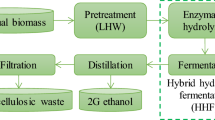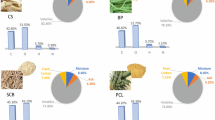Abstract
The transformation of renewable biomass into valuable products as alternatives to fossil fuels is essential for sustainable energy in sustainable society. This work systematically investigates the pyrolysis of sorghum bagasse biomass into bio-char and bio-oil products and studies the effect of temperature (623–823 K) on the conversion of sorghum bagasse and products yields. The physicochemical properties of bio-char were thoroughly studied using powder X-ray diffraction, elemental analysis (CHNSO), scanning electronic microscope, calorific value (CV), and Fourier transform infrared (FTIR) spectroscopy techniques. Also, gas chromatography–mass spectrometry (GC–MS), CV, and FTIR were used to understand the properties of bio-oil. The results obtained indicate that an increase in the pyrolysis temperature from 623 to 823 K leads to a decrease in the bio-char yield from 42.55 to 30.38%. On the other hand, the maximum bio-oil yield of 15.94% was obtained at 723 K. The bio-char obtained at 673 and 773 K was found by FTIR analysis to be composed of a highly ordered aromatic carbon structure. The calorific value of bio-oil, which contains a greater amount of acidic compounds, was found to be 6740 kcal/kg. The GC–MS analyses revealed the presence of octadecenoic acid, p-cresol, 2,6-dimethoxy phenol, 4-ethyl 2-methoxy phenol, phenol, o-guaiacol, and octadecanoic acid in the bio-oil obtained from the pyrolysis of sorghum bagasse biomass. The present study provides useful information for understanding the quality of bio-oil and bio-char obtained from high biomass sorghum bagasse.








Similar content being viewed by others
References
Wenzel WG, Van Rooyen PJ. Moisture stress and potential sorghum yield. Int Sorghum Millets Newsl. 2001;42:28–9.
Ismail Syed, Adsul PB, Shinde GG, Deshmukh AS. Impact of FYM and fertilizer nitrogen on yield and soil properties of sorghum grown on Vertisol. Int Sorghum Millets Newsl. 2001;42:29–31.
Nageshwar Rao TG, Narayana YD, Seetharama N. Survey of the incidence of diseases of sorghum in Karnataka during rainy season of 2005. Int Sorghum Millets Newsl. 2006;47:64–5.
Gopal Reddy V, Upadhyaya HD, Gowda CLL. Current status of sorghum genetic resources at ICRISAT. Their sharing and impacts. Int Sorghum Millets Newsl. 2006;47:9–13.
Krishnamurthy L, Reddy BVS, Serraj R. Screening Sorghum germplasm for tolerance to soil salinity. Int Sorghum Millets Newsl. 2003;44:90–2.
Kumar CG, Srinivasa Rao P. Soma Gupta, Jayalakshmi Malapaka, Ahmed Kamal. Enhancing the shelf life of sweet sorghum [sorghum bicolor (l.) moench] juice through pasteurization while sustaining fermentation efficiency. Sugar Tech. 2013;15(3):328–37.
Nageshwar Rao TG, Kumar SR. Influence of genotype × management interaction on disease development in sorghum. Int Sorghum Millets Newsl. 2006;47:61–3.
Manya JJ. Pyrolysis for biochar purposes. A review to establish current knowledge gaps and research needs. Environ Sci Technol. 2012;46:7939–54.
Qian K, Kumar A, Patil K, Bellmer D, Wang D, Yuan W, Huhnke RL. Effects of biomass feedstocks and gasification conditions on the physiochemical properties of char. Energies. 2013;6:3972–86.
Masek O, Brownsort P, Cross A, Sohi S. Influence of production conditions on the yield and environmental stability of biochar. Fuel. 2013;103:151–5.
Lopez MCB, Blanco CG, Martinez-Alonso A, Tascon JMD. Composition of gases released during olive stones pyrolysis. J Anal Appl Pyrol. 2002;65:313–22.
Wang D, Czernik S, Montane D, Mann M, Chornet E. Biomass to hydrogen via fast pyrolysis and catalytic steam reforming of the pyrolysis oil or its fractions. Ind Eng Chem Res. 1997;36:1507–18.
Gercel HF. Production and characterization of pyrolysis liquids from sunflower-pressed bagasse. Bioresour Technol. 2002;85:113–7.
Agrawalla A, Kumar S, Singh RK. Pyrolysis of groundnut de-oiled cake and characterization of the liquid product. Bioresour Technol. 2011;102:10711–6.
Nayan NK, Kumar S, Singh RK. Production of the liquid fuel by thermal pyrolysis of neem seed. Fuel. 2013;103:437–43.
Singh RK, Shadangi KP. Liquid fuel from castor seeds by pyrolysis. Fuel. 2011;90:2538–44.
Shadangi KP, Singh RK. Thermolysis of polanga seed cake to bio-oil using semi batch reactor. Fuel. 2012;97:450–6.
Sensoz S, Angin D. Pyrolysis of safflower (Charthamus tinctorius L.) seed press cake: part 1. The effects of pyrolysis parameters on the product yields. Bioresour Technol. 2008;99:5492–7.
Piskorz J, Majerski P, Radlein D, Scott DS, Bridgwater AV. Fast pyrolysis of sweet sorghum and sweet sorghum bagasse. J Anal Appl Pyrol. 1998;46:15–29.
Kotaiah Naik D, Satyavathi B, Parthasarathy R. Pre-treatment of Karanja biomass via torrefaction: effect on syngas yield and char composition. APCChE Congress incorporating Chemeca 2015, Melbourne, Victoria.
Di Blasi C. Combustion and gasification rates of lignocellulosic chars. Prog Energy Combust Sci. 2009;35:121–40.
Huang L, Ding T, Liu R, Cai J. Prediction of concentration profiles and theoretical yields in lignocellulosic biomass pyrolysis. J Therm Anal Calorim. 2015;120:1473–82.
Robert JM, Thomas AM. Molecular characterization of the pyrolysis of biomass. Energy Fuels. 1987;1:123–37.
Nikzad M, Movagharnejad K, Talebnia F, Najafpour G, Ghorban A, Farahi H. Study on alkali pretreatment conditions of sorghum stem for maximum sugar recovery using statistical approach. Chem Ind Chem Eng Q. 2014;20:261–71.
Kwon SM, Kim NH, Cha DS. An investigation on the transition characteristics of the wood cell walls during carbonization. Wood Sci Technol. 2009;43:487–98.
Nishimiya K, Hata T, Imamura Y, Ishihara S. Analysis of chemical structure of wood charcoal by X-ray photoelectron spectroscopy. J Wood Sci. 1988;44:56–61.
Zickler GA, Wagermaier W, Funari SS, Burghammer M, Paris O. In situ X-ray diffraction investigation of thermal decomposition of wood cellulose. J Anal Appl Pyrol. 2007;80:134–40.
Wei L, Liang S, Guho NM, Hanson AJ, Smith MW, Garcia-Perez M, McDonald AG. Production and characterization of bio-oil and biochar from the pyrolysis of residual bacterial biomass from a polyhydroxyalkanoate production process. J Anal Appl Pyrol. 2015;115:268–78.
Varma AK, Mondal P. Physicochemical characterization and kinetic study of pine needle for pyrolysis process. J Therm Anal Calorim. 2016;124:487–97.
Joshi G, Rawat DS, Lamba BY, Bisht KK, Kumar P, Kumar N, Kumar S. Transesterification of Jatropha and Karanja oils by using waste egg shell derived calcium based mixed metal oxides. Energy Convers Manag. 2015;96:258–67.
Yang H, Yan R, Chen H, Lee DH, Zheng C. Characteristics of hemicellulose, cellulose and lignin pyrolysis. Fuel. 2007;86:1781–8.
Silverstein RM, Webster FX, Kiemle DJ, Bryce DL. A good general reference for more detailed information on interpretation of infrared spectra (as well as other spectroscopic techniques) is Silverstein, spectrometric identification of organic compounds. 8th ed. New York: Wiley; 2014.
YinR Liu R, Mei Y, Fei W, Sun X. Characterization of bio-oil and bio-char obtained from sweet sorghum bagasse fast pyrolysis with fractional condensers. Fuel. 2013;112:96–104.
Author information
Authors and Affiliations
Corresponding author
Rights and permissions
About this article
Cite this article
Kotaiah Naik, D., Monika, K., Prabhakar, S. et al. Pyrolysis of sorghum bagasse biomass into bio-char and bio-oil products. J Therm Anal Calorim 127, 1277–1289 (2017). https://doi.org/10.1007/s10973-016-6061-y
Received:
Accepted:
Published:
Issue Date:
DOI: https://doi.org/10.1007/s10973-016-6061-y




